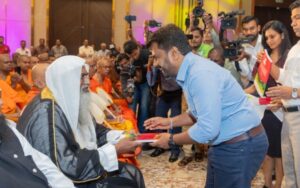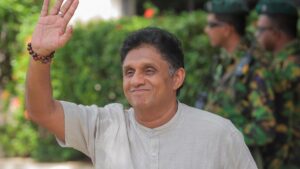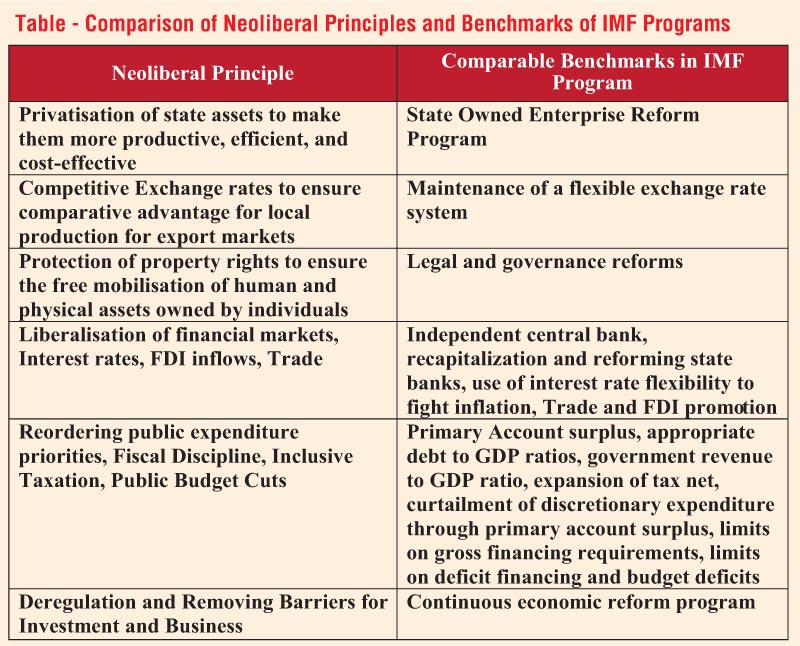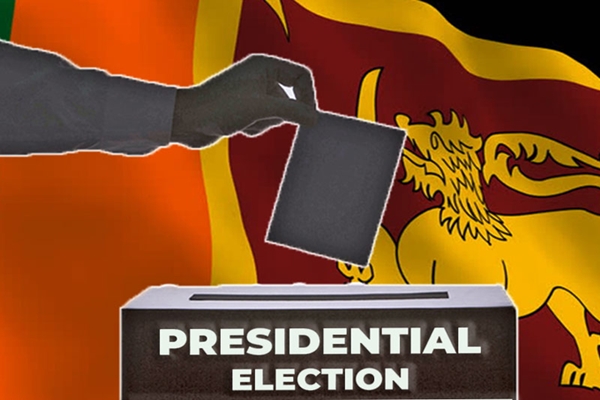Choosing from three frontrunners
Though there are 39 names on the ballot paper, as the recent developments have shown, the fight is only among three contenders. They are President Ranil Wickremesinghe or Ranil for short, Opposition leader Sajith Premadasa or Sajith, and the JVP leader Anura Kumara Dissanayake or Anura. All the three have now released their election manifestos for perusal of the voters1. From the manifestos as well as from the stand they have taken so far at the election platforms, the economic ideology of each of these three leading candidates has now been revealed to the electorate.
Ranil’s neoliberalism
 Ranil’s election campaign, as promoted by him as well as his supporters, has been based on one specific success story. That is, within such a short period of two years, he has been able to rescue the bankrupt economy by faithfully adopting a policy package agreed with IMF when the country got a financing facility under its extended fund facility or EFF. If Sri Lanka breaks away from this policy package in the next five years, Ranil maintains that the reversion to the economic catastrophe which it had two years ago cannot be avoided. Hence, to continue with this policy, Ranil should be reelected as the President.
Ranil’s election campaign, as promoted by him as well as his supporters, has been based on one specific success story. That is, within such a short period of two years, he has been able to rescue the bankrupt economy by faithfully adopting a policy package agreed with IMF when the country got a financing facility under its extended fund facility or EFF. If Sri Lanka breaks away from this policy package in the next five years, Ranil maintains that the reversion to the economic catastrophe which it had two years ago cannot be avoided. Hence, to continue with this policy, Ranil should be reelected as the President.
When the manifesto was presented to the people last week, Ranil emphasised that it has been designed within the policy framework of the IMF’s EFF conditions2. The framework which his Government has agreed with IMF has been codified into law through the enactment of the Economic Transformation Act that binds all future governments to honour them. These policy parameters which IMF gets member countries to accept when granting financing facilities are based on the neoliberal economic ideology which was in vogue in 1990s. Since this ideology was upheld by the three Washington DC based institutions, IMF, World Bank, and the US Treasury, this was christened as Washington Consensus by the British economist John Williamson3.
After the failure of the Washington Consensus in 1990s when it was implemented in Latin American countries, its original advocates abandoned it at a meeting held in Barcelona in 20044. However, IMF continued to follow neoliberalism as the policy agenda when it prescribed policy proposals to borrowing countries. Since Ranil is to continue this policy package after reelection, he is asking the voters to endorse the neoliberal economic ideology.
No-existent Theravada Trading Economy
The table presents a comparison of neoliberal economic principles and the benchmarks under the IMF program being implemented by the present Government. They are one and the same. However, Ranil has been careful not to present them as neoliberal or IMF policies since such a position does not sit well with the breakaway group of the Sri Lanka Podujana Party which supports him. This group is known for its animosity for neoliberal economic policies adopted by previous Ranil Wickremesinghe governments. Hence, he has rebranded them as Theravada Market Economics, a more acceptable and easily marketable package to a predominantly Buddhist voter base in Sri Lanka, specifically the Buddhist clergy.
His position has been that in the ancient times, both Lanka and Thailand, called Siam at that time, had the system of Theravada Trading Economy which spanned over 18 centuries one after the other before it broke down. Theravada Buddhism was brought to the island known as Lanka at that time in the 3rd century BCE, but the country was a vibrant trading nation for millennia prior to that period.
According to the great chronicle Mahavansa, when Prince Vijaya landed in Thammanna in ancient Lanka in the 6th century BCE, Princess Kuveni is said to have fed him and his retinue with a meal of rice procured from ships that had been wrecked in the high seas. In addition, she is said to have offered them other articles of value procured from the same source5. What this means is long before Theravada religion was brought to Lanka, it was a vibrant trading economy. It was a trading nation but not according to Buddhist principles, though the monarchy had been active supporters of the Master’s religion.
The trading processes and taxation principles were based on ancient Indian principles of economics, and they were presented in textbook form by Indian economics Gurus like Kautilya, the penname of Brahman Chanakya who helped King Chandragupta to ascend to the throne in Magadha in the 4th century BCE by defeating the Nanda dynasty. Kautilya wrote the first ever textbook on economics for training prospective kings titled The Arthashastra. It can be presumed that the Lankan kings and princes who sought to assume kingship later may have followed these principles of economics liberally. Even as late as the 12th century CE, King Parakramabahu the First is said to have mastered the ways of Chanakya for gaining wisdom for ruling the kingdom6.
According to Kautilya, the purpose of life at that time had been threefold: Dhamma or spiritual good, Artha or material wellbeing, and Kama or aesthetic pleasures7. The Buddha had preached some guides on economic principles which his lay followers should follow to make this life as well as the one afterlife a purposeful one. These principles which have been categorised as Buddhist economics has been presented in an essay by E F Schumacher, the British statistician and economist of German origin and of ‘Small Is Beautiful’ fame8. It is clear what the ancient kings in Lanka or Thailand followed as their economic policy strategy is far from these Buddhist principles.
For instance, quoting the Arabian geographer Al-Idrisi, Historian Senerat Paranavitana says that during the time of Parakramabahu, I, alcohol has been brought to Lanka from Irek and Perse and the king had bought such alcohol and made a monopoly state trading9. Dealing in alcohol is not supported by Buddhist economics. Hence, Theravada Trading Economy is a new branding assigned to the ancient, globalised trading economy that prevailed in Sri Lanka as well as in Siam to conceal Ranil’s IMF sponsored neoliberal economic policies. In modern Thailand, there is a globalised economy based on basic global economic principles. That economy cannot be called Theravada Trading Economy.
 Dirigisme or statism to oppose neoliberalism
Dirigisme or statism to oppose neoliberalism
At the opposite pole of neoliberalism, there is dirigisme or statism as a development strategy. According to Britannica Money, dirigisme is an approach to economic development emphasising the positive role of state intervention10. These policies include central direction of the economy controlling investment, wages and prices, and supervising labour markets. The Soviet Union had dirigiste policies before it collapsed in early 1990s. Today, the North Korean economy is an example of strictly following this policy. During 1970 to 1977, Sri Lanka also followed a lesser strict version of dirigisme.
Any political party which advocates the expansion of the state sector at the expense of the private sector involvement also follows dirigiste or statist policies. France adopted a dirigiste policy package in 1950s and 1960s, but abandoned later when its results were below the expected levels. Two other countries, namely, India and Japan which also went for dirigiste policies abandoned the same in 1990s.
Anura’s dirigiste policies
The policy package proposed by Anura falls into dirigisme or statism but not to an extreme level as is being practiced by North Korea. He has proposed the establishment of 15 odd State sector institutions including a national development bank. There is no mention of the use of the market driven by private initiative and all programs are to be implemented by the strong arm of the Government. For instance, for higher education, the policy package proposes to expand the state university system to accommodate all those who qualify for admission to a university at the GCE (AL) Examination. This is a daunting responsibility assigned to the Government because it requires the Government to find places for about 125,000 students who pass the examination with required marks.
There is no mention of the continuation of the present model implemented by the Government in which private universities are required to play a complementary role to state universities to provide places for unsuccessful students and give a helping hand to state universities to improve quality of teaching as well as research. Policy package does not say that the private universities already established will be absorbed by the state university system. But it says that the Government will introduce a close monitoring and regulatory system to ensure the quality standards of such universities and control the fees they have been charging.
It is a recognised fact in Sri Lanka that there should be a mechanism to ensure the quality standards of all universities in the country, private as well as state-owned. If Sri Lanka is to become an education hub in the region earning valuable foreign exchange like Malaysia, Thailand or Vietnam, this is one of the foremost requirements to be met.
Absence of revenue base
Anura does not propose to practice dirigisme or statism to an extreme extent. But it is in the opposite pole of neoliberalism being practiced by Ranil now offered to the electorate in sober terms as Theravada Trading Economy. Ranil does not provide the budgetary sources for bringing the debt to a sustainable level or keeping the budgetary gaps at the levels mandated by Parliament when it enacted the Economic Transformation Act. Likewise, a deficiency in Anura’s proposal is the complete silence maintained for the budgetary sources for the expanded Government sector.
Amended neoliberalism as advanced social market economy
 Sajith had declared that his policy ideology is social market economy, a technique which his top economic advisors had borrowed from Ranil when he sought Parliamentary power in 2020. It was developed for him by a team led by Harsha de Silva, his top policy advisor at that time, in July 202011. This policy ideology was also mentioned by Ranil to Parliament that he is being guided by the social market economy ideology, but now he has abandoned it for neoliberalism agreed with IMF, presented to the electorate in a camouflaged form as Theravada Trading Economy.
Sajith had declared that his policy ideology is social market economy, a technique which his top economic advisors had borrowed from Ranil when he sought Parliamentary power in 2020. It was developed for him by a team led by Harsha de Silva, his top policy advisor at that time, in July 202011. This policy ideology was also mentioned by Ranil to Parliament that he is being guided by the social market economy ideology, but now he has abandoned it for neoliberalism agreed with IMF, presented to the electorate in a camouflaged form as Theravada Trading Economy.
But Harsha, now top policy advisor to Sajith, has amended the social market economy as ‘advanced social market economy’ when he released the video clip on his initial speech at the debate on Economic Policies for Tomorrow hosted by the Ceylon Chamber of Commerce in August 202412. It is a rebranding of the ideology like Ranil’s rebranding of neoliberalism as Theravada Trading Economy. Though he has not clarified the departing point, whether it is mere social market economy or advanced social market economy, it lies between Ranil’s neoliberalism camouflaged as Theravada Trading Economy and Anura’s dirigiste economic ideology. It is made up of 10 points: first, transparency and accountability; second, debt crisis management; third, flexible monetary and exchange rate policy; fourth, consolidation of budgetary revenue; fifth, controlling the expenditure of the government; sixth, incentivising growth to reach the required level of becoming a developed country; seventh, digitalisation of the public sector to improve its management; eighth, energy and utilities reforms, ninth, factor market reforms, and the tenth, social safety nets for the vulnerable population. Anyone reading this list will immediately gauge that it is not social market economy policy but an amended version of the IMF’s neoliberal policy package. Hence, in my view, there is no basic difference between Ranil and Sajith as far as IMF is concerned. Either one can successfully negotiate with IMF if elected to power.
Attempt at micromanaging the economy
A weak point of Sajith’s approach is his attempt at micro-managing the economy. This is contrary to the basis public policy assigned to a central government where it is required to handle macro-level economic management. But Sajith wants to use a QR coding system to distinguish between the poorest of the poor who receive handouts in the form of cash grants and the rich classes in society. It is proposed to provide an instant subsidy to those who receive cash grants when they buy fuel and credit the subsidy in real time to their respective account. The rest of the people in society will be charged for fuel at the normal rates. If the difference between these two prices is substantial, the creation of an underground market for fuel is unavoidable.
A system like this prevailed during 1970-77 when people were given rationed quotas for basic items like rice and milk food for children. In either case, those who did not have the means to buy the entire quota were able to sell their unused quota at a commission to those who needed them. Likewise, according to the proposal by Sajith, those who do not need the fuel quota may sell it to others who do want more fuel for use. Sajith will have to spend more money to control this underground market than what he should pay for the subsidy to be granted to the needy people.
Choice of the voters
Hence, voters at the forthcoming Presidential election will be asked to choose between neoliberalism camouflaged as Theravada Trading Economy, neoliberalism rebranded as advanced social market economy or a slightly relaxed policy package containing dirigiste or statist policies.

Footnotes:
1Anura’s manifesto can be found at https://www.npp.lk/up/policies/si/npppolicystatement.pdf?ok, Ranil’s manifesto at https://www.ranil2024.lk/manifesto, and Sajith’s manifesto at http://ads.newswire.lk/pdf/election/sajith/manifesto-e.pdf.
2https://www.youtube.com/watch?v=EqDw0xvzJ_0
3https://www.piie.com/blogs/realtime-economic-issues-watch/what-washington-consensus
4https://en.wikipedia.org/wiki/Barcelona_Development_Agenda
5Mahavansa, Part I, Mudliyar L C Wijsinha translation, Asian Education Services, New Delhi, p 33.
6Mahavansa, Part II, Mudliyar L C Wijesinha translation, Asian Education Services, New Delhi, p 127.
7The Arthashastra, L N Rangarajan translation, Penguin books, p 100.
8https://centerforneweconomics.org/publications/buddhist-economics/
9History of Ceylon by the University of Ceylon, Vol I, Part II, Sinhala translation by Vidyalankara University, p 523.
10https://www.britannica.com/money/dirigisme
11https://www.dailymirror.lk/amp/business-main/next-5-years-economic-policy-in-the-making-harsha/245-76735
12https://www.youtube.com/watch?v=NLwsQQoStsQ&t=117s
